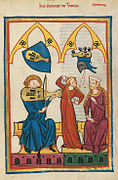- Mozarabic miniature of a Beato dated around 900-950 in Spain. BNE Vitr. 14/1. Folio 130r.
- Image cropped from the Cantigas de Santa Maria (codex MS T.I. 1). Two vielles (left) and a citole. Spain, c. 1280.
- Vielle or fiddle from c. 1310,
Ormesby Psalter, Bodleian Library - Vielle from the Codex Manesse, UB Heidelberg, c. 1305-1315.
- Modern build of a viella from Spain. Based on a sculpture instrument at the Mirta Caviello del Portico de la Gloria de Santiago de Compostela.
- Reinmar the fiddler, from the Codex Manesse.
Germany, c. 1305-1315.  Player of a three-string vielle. Image in margin of Peterborough Psalter.
Player of a three-string vielle. Image in margin of Peterborough Psalter.
Early 14th Century.- Half-man, half-beast playing a three-string vielle left-handed. Image in margin of the Hours of Charles the Noble.
Early 15th Century.
music.wikisort.org - Instrument
The vielle /viˈɛl/ is a European bowed stringed instrument used in the medieval period, similar to a modern violin but with a somewhat longer and deeper body, three to five gut strings, and a leaf-shaped pegbox with frontal tuning pegs, sometimes with a figure-8 shaped body.[citation needed] Whatever external form they had, the box-soundchest consisted of back and belly joined by ribs, which experience has shown to be the construction for bowed instruments. The most common shape given to the earliest vielles in France was an oval, which with its modifications remained in favour until the Italian lira da braccio asserted itself as the better type, leading to the violin.[1]
 Modern reconstruction of a vielle depicted in a painting by Hans Memling | |
| Classification |
|
|---|---|
| Related instruments | |
|
Bowed
Plucked | |
The instrument was also known as a fidel or a viuola, although the French name for the instrument, vielle, is generally used; the word comes from the same root as fiddle. It was one of the most popular instruments of the medieval period, and was used by troubadours and jongleurs from the 13th through the 15th centuries. The vielle possibly derived from the lira, a Byzantine bowed instrument closely related to the rebab, an Arab bowed instrument.[2] There are many medieval illustrations of different types of vielles in manuscripts,[3] sculptures and paintings.
Starting in the middle or end of the 15th century, the word vielle was used to refer to the hurdy-gurdy, as a shortened form of its name: vielle à roue ("vielle with a wheel").[4]
Several modern groups of musicians have formed into bands to play early music (pre-Baroque), and they sometimes include vielles, or modern reproductions, in their ensembles, together with other instruments such as rebecs and saz.
Gallery
References
- One or more of the preceding sentences incorporates text from a publication now in the public domain: Schlesinger, Kathleen (1911). "Vielle". In Chisholm, Hugh (ed.). Encyclopædia Britannica. Vol. 28 (11th ed.). Cambridge University Press. p. 50.
- "fiddle," Encyclopædia Britannica, from Encyclopædia Britannica Online: http://www.britannica.com/EBchecked/topic/206069/fiddle (retrieved March 06, 2009)
- (in French) Roi David jouant de la vièle en huit
- Schlesinger 1911.
External links
На других языках
- [en] Vielle
[es] Viola de arco
La viola de arco, vihuela de arco, fídula, viela o giga es un instrumento de cuerda frotada similar al violín, aunque con un cuerpo algo más largo y más profundo, de tres a cinco cuerdas y un clavijero. El sonido se obtiene al frotar las cuerdas con un arco, teniendo el instrumento apoyado en el pecho o en el muslo. Alcanzó gran popularidad durante la Edad Media, siendo utilizado por los trovadores y los juglares desde el siglo XIII al siglo XV. Es un instrumento que dejó de usarse en Europa desde ya varios siglos, actualmente solo se interpreta por músicos especializados en música antigua y en los pueblos de la amazonía ecuatoriana.[1][ru] Фидель (музыкальный инструмент)
Фиде́ль (нем. Fiedel), вие́ла (фр. vièle, vielle, лат. viella), фидл (англ. fiddle)[1] — обозначение группы струнных смычковых инструментов, широко распространённых в средневековой Европе.Другой контент может иметь иную лицензию. Перед использованием материалов сайта WikiSort.org внимательно изучите правила лицензирования конкретных элементов наполнения сайта.
WikiSort.org - проект по пересортировке и дополнению контента Википедии







